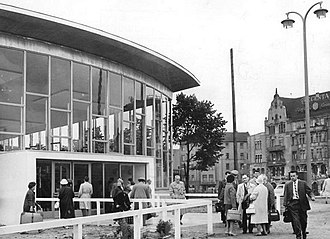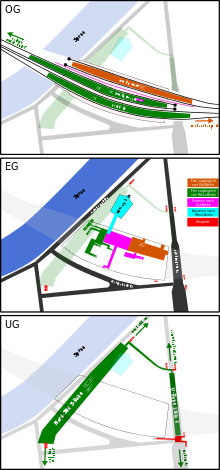Palace of Tears
Tränenpalast is the colloquial term in Berlin for the former exit hall of the Friedrichstrasse railway station border crossing point in East Berlin in the historic Dorotheenstadt district of the Mitte district . S-Bahn , U-Bahn and long-distance trains from the GDR went from here to West Berlin .
The name Tränenpalast is derived from the fact that most GDR citizens did not have the freedom to travel to West Berlin during the period mentioned and had to say goodbye to their western visitors here in tears.
The control and clearance counters of the border troops of the GDR were located in the Tränenpalast .
history
The building was planned by the architect Horst Lüderitz. The border crossing point separated the station area with its entry and exit flows about a year after the wall was built . The client was the DR (design and surveying office, building construction group of the DR). In terms of architecture, a cantilevered steel-glass construction and ceramic cladding were intended to tie in with the standards of contemporary international architecture and to conceal the actual function. Access was only permitted for passengers on the S, U or long-distance trains; According to the information board at the Tränenpalast, tickets could be purchased on the platforms (in DM West). However, tickets for destinations in West Berlin or the FRG (in italics: original text GDR) were also sold at the counters for urban transport in the capital Berlin or the DR (in Mark Ost).
Border clearance

After the leaving the country from the GDR people themselves had been placed in a queue in front of the Palace of Tears, they were usually two at the entrance of the building Volkspolizisten visually inspected upon presentation of the identity card or the passport and visa "preflighting". So-called unauthorized persons (e.g. relatives of those leaving) were turned away at this door check . A jam area followed in front of the actual control point.
Inside the building, stairs led down to the customs control . There was an open check-in counter in the front part of the hall to the left and right of the main path. The export of GDR currency to the West was forbidden, so any remaining money (often amounts under ten marks) had to be paid into a special account at a branch of the state bank before customs control (this money could be withdrawn again when entering the country again). Furthermore, the export regulations for goods had to be observed, the objects carried (often books that were bought by forced exchange ) had to be entered in a customs export declaration beforehand. Travel bags and suitcases were often searched here.
After the customs control, the actual verification of the travel documents took place. For this purpose, there were around ten check-in counters arranged side by side in the rear part of the hall. They were made of square steel tubing and clad with Sprelacart panels. Next to each passage there were light fields to classify the departing people according to "Citizens of Berlin (West)", "Citizens of the FRG", "Citizens of the GDR" and "Citizens of other countries". Here the exact control of the passports or identity cards and the visas took place. After the "clearance", a door was opened briefly with a buzzer and the part of the Friedrichstrasse station reserved for western traffic could be entered.
There were travel options in the western part of Berlin with the subway in the direction of Wedding , Tegel or Kreuzberg , Tempelhof , Mariendorf and with the S-Bahn to Zoologischer Garten , Wannsee (west), Gesundbrunnen , Frohnau , Heiligensee (north) and Anhalter Bahnhof , Schöneberg , Zehlendorf , Lichterfelde , Lichtenrade (south). In addition, the long-distance platform could be reached. The travel times of the U-Bahn and S-Bahn were adjusted to the regular opening times of the border crossing point, with the last trains running around two o'clock at night. Delayed departures had to spend the night in special rooms at Friedrichstrasse station until the first train the next morning.
Entry into East Berlin took place through the station facilities of Friedrichstrasse station, not through the Palace of Tears. In contrast to other border crossing points, this border crossing was open to all nationalities, not only for West Berliners, but also for FRG citizens and foreigners (both socialist and non-socialist countries). The only alternative for foreigners was the Checkpoint Charlie crossing, also on Friedrichstrasse. For these “citizens of other countries” the crossing was open day and night; In contrast to "Citizens from West Berlin" and "Citizens of the FRG", they were able to re-enter immediately after midnight after leaving the country - which had to take place by midnight at the latest. For all other citizens there were restrictions; the crossing point was not always open. For West Berliners , there was an extension to 2 a.m. in the 1980s. For many “citizens of other countries”, the Palace of Tears was a constant transit point that had to be passed at midnight. The exit had to take place at the same border crossing as the entry. West Berliners had to indicate the desired crossing point when applying for entry in the offices for visiting and travel matters.
Since this border crossing point was in the middle of East Berlin territory and could only be reached by underground, suburban or long-distance trains, the options for controls on the West Berlin side were severely limited. The nearest S-Bahn and U-Bahn stations in West Berlin were randomly checked , in particular by western customs officers who were looking for larger quantities of spirits and cigarettes purchased duty-free and tax-free in the Intershop . This gave the GDR the opportunity to deport foreigners to the West without any problems (e.g. asylum seekers ).
Between 2:17 a.m. and 4:30 a.m. there was no S- or U-Bahn traffic going west. Passengers who missed the last train had to stay on Genex premises in the transit area.
Use after reunification

An originally existing connecting corridor to Friedrichstrasse station was removed after the border was opened in 1990. After German reunification in 1991, the former Tränenpalast became a club of the same name with various cultural events ( discotheque , cabaret and other live events). On October 2, 1990, the Palace of Tears was placed under monument protection. Out of uncertainty about what would happen to the building in the future, the GDR government initiated this step one day before reunification. The club had to close in July 2006 because the Berlin Senate sold the property. Cultural use was prescribed for the future.
On the surrounding property - bounded by the Friedrichstrasse train station, Reichstagufer and Friedrichstrasse - an office complex called " Spreedreieck " was built. The circumstances surrounding the sale of the property to the investor are to be clarified by a parliamentary committee of inquiry from the Berlin House of Representatives .
In use since September 2011
In November 2008, the use of the building as a place of remembrance and exhibition space was established with the “update of the federal memorial concept”. After the completion of extensive renovation and renovation measures, the Foundation House of History of the Federal Republic of Germany has been offering the permanent exhibition "Everyday life in the division of Germany" in the listed Tears Palace since September 15, 2011 . Admission is free. With biographical examples, original objects and interviews with contemporary witnesses, it illustrates life in the face of division and boundaries on 550 square meters of exhibition space. It also shows the most important stages in the unification process. The exhibition objects include original and reconstructed check-in cabins as they were in use in the Tränenpalast, as well as a 1:87 scale model that illustrates the exit and entry movements in the entire facility - consisting of the Tränenpalast and Friedrichstrasse station. The exhibition was opened by Chancellor Angela Merkel on September 14, 2011. In the first two weeks after opening, it was visited by more than 30,000 visitors.
A tenancy agreement with the Bonn House of the History of the Federal Republic of Germany was signed in January 2010 for a period of 20 years.
- Original signs and signs in the Palace of Tears
literature
- Martin Kaule: Relics of the State Security. Structural legacies of the MfS. Links, Berlin 2014, ISBN 978-3-86153-765-6 .
- More tears flowed here than anywhere else. In: Berliner Morgenpost , September 14, 2011.
- Philipp Springer: Station of Tears. The border crossing point Berlin-Friedrichstrasse. Links, Berlin 2013, ISBN 978-3-86153-719-9 .
- Dorothea Kraus, Foundation House of History of the Federal Republic of Germany: Tränenpalast. Place of German division. Bonn, 2015, ISBN 978-3-937086-23-1 .
Web links
- Palace of Tears. Everyday life in the division of Germany. Palace of Tears website
- Official website of the Palace of Tears
- Mourning for the Palace of Tears . In: Stern , August 2, 2006
- Postcard view from 1964
- Entry in the Berlin State Monument List with further information
- The exhibition in the museum magazine 04/2015
- Contemporary witness portal (House of History)
Individual evidence
- ↑ Cf. Alfred Gottwaldt: With light handwriting. Memories of Horst Lüderitz, Reichsbahn architect of the “Tränenpalast” at Berlin-Friedrichstrasse station . In: EisenbahnGeschichte 68 (2015), pp. 19–23.
- ^ Source: Monument database of the Senate Department for Urban Development Berlin
- ↑ The house is my destiny - Ten years ago, Marcus Herold opened the Tränenpalast as a venue. In: Berliner Zeitung , November 28, 2001
- ↑ a b History of the Tränenpalast at a glance , on the HdG website for the Tränenpalast.
- ↑ The curtain falls into the unknown. At: Spiegel Online , July 12, 2006
- ^ Opposition requests investigation of the Spreedreieck scandal . In: the daily newspaper , April 17, 2008
- ↑ Tränenpalast - House of History Foundation
- ↑ Exhibition: Already 30,000 visitors to the show in the Tränenpalast . In: Berliner Morgenpost , October 4, 2011
- ↑ The House of History will document the German-German division in the Berlin “Tränenpalast” . In: General-Anzeiger , November 15, 2008
- ↑ Strong commitment in Berlin . In: General-Anzeiger , January 26, 2010
Coordinates: 52 ° 31 ′ 15 ″ N , 13 ° 23 ′ 13 ″ E








